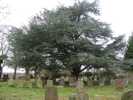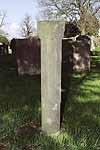For this church:    |
Rolleston Holy TrinityChurchyard
Planted in the churchyard are trees commemorating anniversaries. The churchyard is still open for burials, but was almost full in 2015. There is a small area on the north wall, near the west end for cremated remains and markers, which has been supplemented by a special area on the south side of the churchyard, designated separately. There are extensive records of burials back to the 16th century, but the earliest legible grave marker is 1694. The records are held in Nottinghamshire archives, with copies of many of those records in the church. The most notable churchyard memorial is to John Tidy (1778-1823). John was born in Rolleston the son of John (of South Muskham) and Sarah TIDEY (nee PEACE of East Markham) and christened in Holy Trinity church on 8th November 1778. He had five siblings, Robert (1771 S. Muskham); Sarah (1772 Rolleston); Elizabeth (1774 Rolleston); Anne (1776 Rolleston) and Mary (1783 Rolleston). The Parish Records show he was married after Banns in Holy Trinity church on 11th February 1822 to Mary NOUTCH, both of the parish (although Mary was born in Langford), in the presence of Elizabeth REYNOLDS and Joseph CHILDS. John made his mark but Mary signed her name. He was only married for a year and a half before he died on 10th October 1823, and the parish records show that he was buried in Holy Trinity churchyard on 12th October 1823. The 1988 Autumn edition of the magazine 'This England' had an article entitled 'A Waterloo Man', and the author of the article stated that in 1930 the engraving was legible and was as follows:
During the Peninsular War (1808-1814) there were several battles fought close to the river D[o]uro, which is quite a long river, but the main battle was in 1809 at Oporto which is situated at the mouth of the river, and can hardly be called a 'stream' at this point, except perhaps for poetic licence to rhyme with 'scene'. If the inscription can be taken literally then John fought in the Peninsular War and not necessarily at Waterloo, (1815) but then again the verses might be a 'standard' one for soldiers who fought with Wellington in both Theatres of War. He only had time to father one son, John, christened on 22 June 1823 in Holy Trinity church, and John and Mary were shown as shopkeepers. The son moved to Newark (1841 Census), then onto Nottingham, working in the Lace Trade where he married Sarah TAYLOR in 1846, subsequently dying in 1872 and being buried in Lenton churchyard. He had four sons and two daughters and all the sons survived, married and had eighteen children between them! Sundial
There is a Grade II listed sundial in the south part of the churchyard. Details of the sundial are available in the Listing Description section. |







